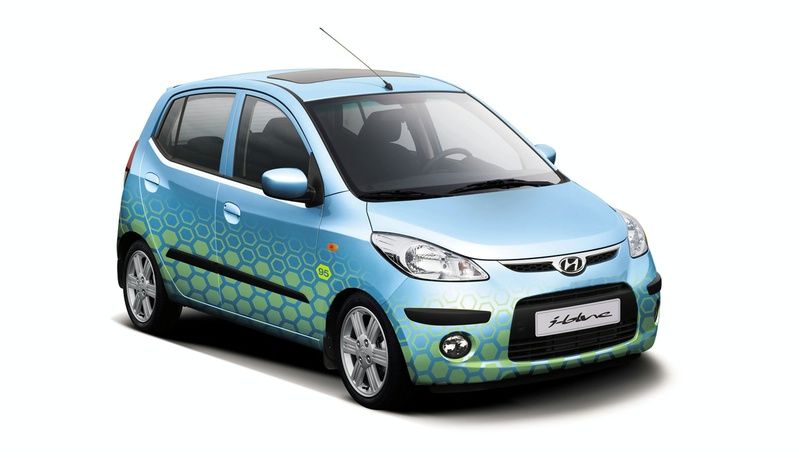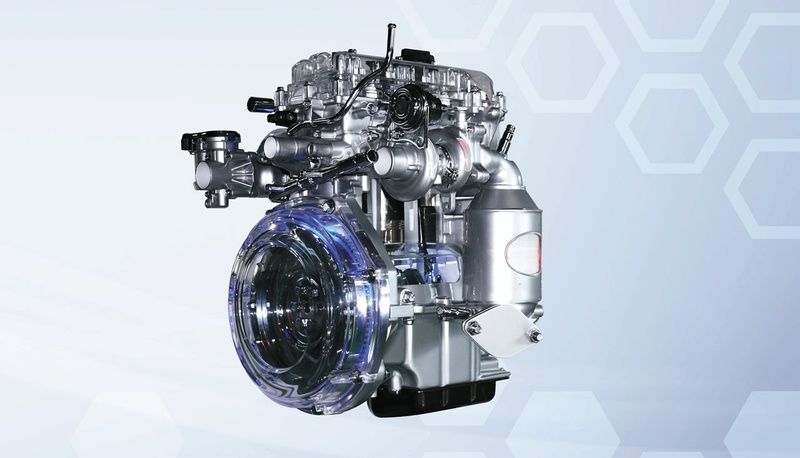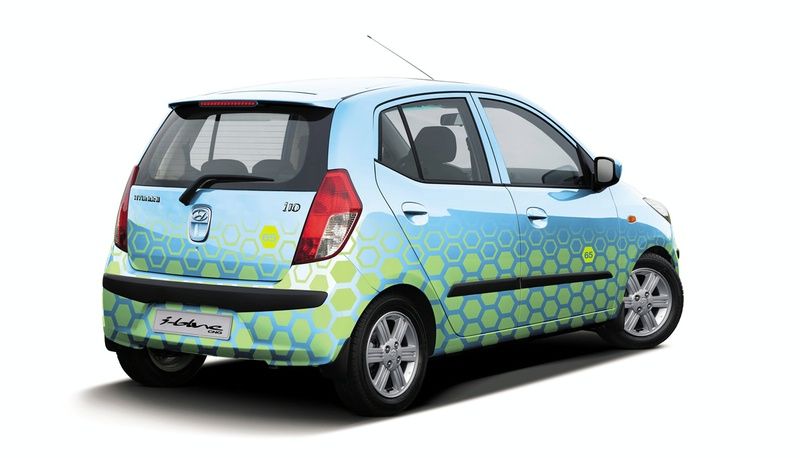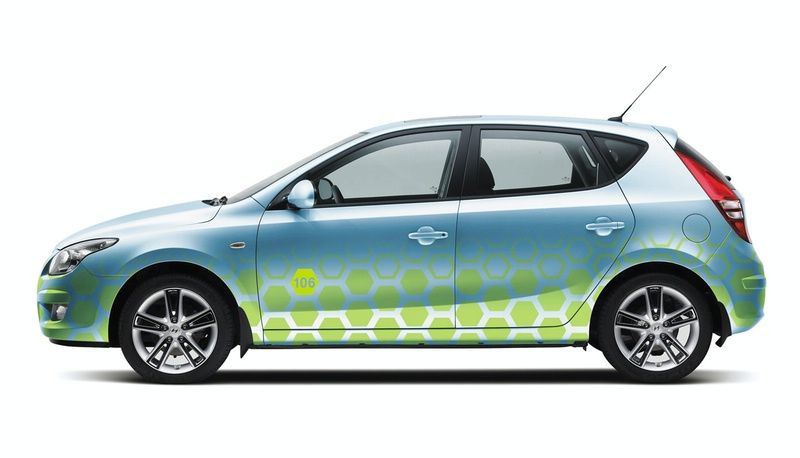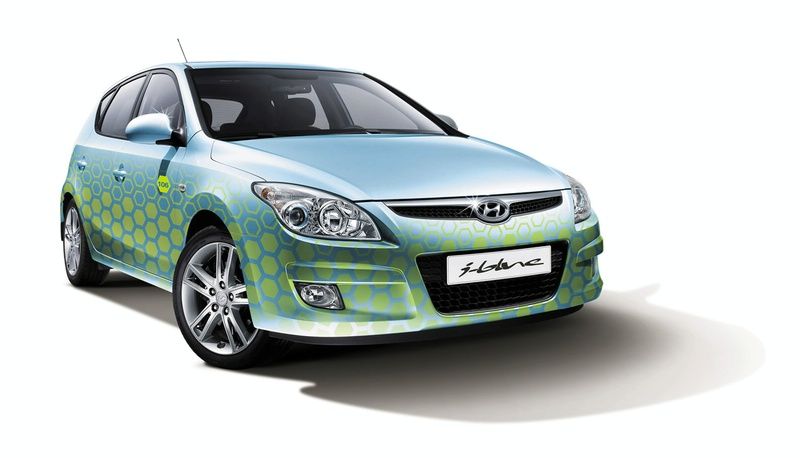Originally unveiled at the Geneva Motor Show in 2008, the i-blue concept is an optimized combination of currently available technologies (i-blue package) with a completely new engine that is powered by compressed natural gas (CNG.) the i-blue was shown in three different variations -- the i30, i10 and i10 CNG.
The i30 blue is powered by a 1.6CRDi diesel engine that delivers 90 hp. It emits an impressively low 125 g/km CO2.
The i10 blue the i10 brought a new sophistication to the entry level of the Hyundai range. The highly economic 75PS new 1.1CRDi 5-door already has a very low emission level of just 114 g/km CO2. With the essential elements of the i-blue package, this can be reduced to just 95 g/km. A meaningful 17% reduction.
The i10 blue CNG - the ultimate solution of an ecologically optimized vehicle however is achieved through the bivalent combination of the newly developed 0.8L 3-cylinder turbocharged engine (98PS) and a CNG application. In this package, the i10 blue CNG reaches class leading level of just 65g/km CO2.
Press release after the jump.
2008 Hyundai i-Blue
- Make: Array
- Model: 2008 Hyundai i-Blue
2008 Bentley GTZ by Zagato
- Make: Array
- Model: 2008 Bentley GTZ by Zagato
- [do not use] Vehicle Model: Array
Press release
At the Geneva International Motor Show Hyundai Motor Co. will be presenting the i-blue concept, an optimized combination of currently available technologies (i-blue package) with a completely new engine and a CNG application. The i-blue concept allows mass-production of highly eco-friendly vehicles - today.
CO2 emissions are at the core of eco-politics - Hyundai can make even further progress in reducing CO2. As the need to reduce green house gases, cut consumption and preserve resources becomes ever more imperative, new developments are crucial. With the i-blue concept, Hyundai has combined several cutting edge technologies to meet ever-rising customer and legislative demands.
The result is a range of technologies, based upon the i10, i10 CNG, i30 and the forthcoming i20, engineered to set new practical standards in CO2 reduction and fuel economy.
“The i-blue concept can be thought of as an introduction of features that will naturally evolve in future Hyundai cars. But if distributor, dealer and public demand justifies it, could become a stand-alone eco-dynamic model range. Either way, given the fact that we already produce class leading vehicles in terms of CO2 reduction, for example the current Santa Fe CRDi, it is a practical demonstration of the on-going commitment of Hyundai to both our customers and the eco-sphere,” explains Hans van Gent of Hyundai Motor Europe Technical Center GmbH.
Visibly distinguished by the i-blue badges, each model offers significant reductions in pollution, without compromising performance, reliability and driving satisfaction.
i-blue Package Content:
While the individual models differ in the exact combination of i-blue features, the overall package comprises advances in drag reduction, increased engine and transmission efficiency, and chassis fine-tuning.
Aerodynamic Improvements:
To achieve a major (up to 10%) reduction in Cd drag coefficient, the i-blue package includes:
- Vehicle specific full under-floor streamlining
- Aerodynamically optimized wheel housings, front and rear
- Optimized front air intake and rear spoiler
Powertrain
Elements that combine to achieve a major reduction in fuel consumption include:
- Increasing the inner motor efficiency by reducing driveline friction, using low friction oil, and optimizing the cooling system
- Changing the engine software control. For example, controlling injection pressure and engine cycle timing, along with enhanced exhaust re-treatment rates, and lowering the engine idling speed
- Fitting an ECU controlled gear change indicator (shift indicator)
- Adopting the Bosch Start & Stop system (incl. intelligent generator)
Chassis
In order to maximize both aerodynamic and fuel efficiency gains, the chassis will be further fine-tuned. Changes include:
- Suspension lowered by circa 15-20mm
- Adoption of very low resistance Michelin tires (i30: 205/55 R16) with increased tyre pressure
Transmission
Hyundai research has shown that changing from a 5 to a 6-speed gearbox and extending the top three ratios delivers a significant reduction in engine speeds with a corresponding reduction in consumption and emissions. Changes include:
- Replacing 5-speed with 6-speed manual gearboxes
- Extending the ratios of the top three gears
- Mounting the shift indicator directly in the instrument display

